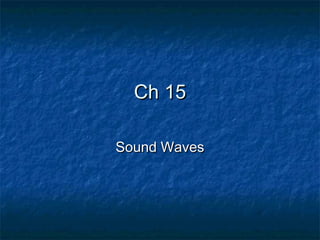
Sound waves
- 2. Sound Wave Properties Sound waves are longitudinal waves consisting of alternate areas of high pressure compressions and low pressure rarefactions The frequency of a sound wave is the # of oscillations in pressure each second The wavelength of a sound wave is the distance between adjacent regions of maximum pressure
- 3. Velocity of a Sound Wave The velocity of a sound wave is 343 m/s at 20 degrees Celsius. The velocity depends on the temperature and increases 0.6 m/s for each Celsius degree increase in temperature. Sound waves generally travel faster in solids and liquids
- 4. How fast will sound travel at 30 degrees Celsius? Answer : 30 – 20 = 10 10 x 0.6 m/s = 6 m/s So, 343 + 6 = 349 m/s
- 5. How fast will sound travel at -5 degrees Celsius? Answer : -5 – 20 = -25 -25 x 0.6 = -15 So, 343 -15 = 328 m/s
- 6. Why does the siren sound different when it is coming toward you than when it is going away? This is called the doppler shift – the apparent change in frequency of a sound wave caused by the motion of either the source or the detector
- 7. Doppler Equation fd = fs (v + vd) (v - vs) fd = detector frequency fs = source frequency v = wave velocity vd = detector velocity vs = source velocity vd and vs are positive if they are moving towards one another and negative if they are moving away from one another
- 8. A police car traveling at 30 m/s towards us sounds the siren at 300 Hz. What frequency do we hear if we are standing still? Answer: 300 (343 + 0)/(343 – 30) = 300 (343/313) = 328.75 Hz
- 9. A police car traveling at 30 m/s towards us sounds the siren at 300 Hz. What frequency do we hear if we are running away at 5 m/s? Answer: 300 (343 + -5)/(343 – 30) = 300 (338/313) = 323.96 Hz
- 10. A police car traveling at 30 m/s towards us sounds the siren at 300 Hz. What frequency do we hear if we are running toward the car at 5 m/s? Answer: 300 (343 + 5)/(343 – 30) = 300 (348/313) = 333.55 Hz
- 11. A police car traveling at 30 m/s away from us sounds the siren at 300 Hz. What frequency do we hear if we are running toward the car at 5 m/s? Answer: 300 (343 + 5)/(343 – - 30) = 300 (348/373) = 279.89 Hz
- 12. More Sound Properties Sound is produced by vibrating objects The pitch is the frequency of the wave Loudness depends on amplitude An octave is two notes whose frequency differ by a ratio of 2:1 Sound level is measured in decibels (dB) For every 20 dB increase the sound is ten times louder.
- 13. How much louder is 100 db than 60 db? Answer 100 – 60 = 40 40/20 = 2 10^2 = 100 x louder
- 14. Sound Definitions Fundamental – lowest resonating frequency (1st harmonic) Harmonics – whole # multiples of the fundamental frequency
- 15. Open-pipe vs closed-pipe resonators
- 16. Closed-pipe Resonators Closed at one end and open at the other The open end is a pressure node and the closed end is a pressure antinode The first resonating frequency is at one-quarter wavelength It resonates at odd-quarter wavelengths and picks up only the odd harmonics Spacing between resonances is one-half a wavelength
- 17. Open-pipe Resonators Open at both ends The ends are pressure nodes The first resonating frequency is at one- half wavelength It resonates at all half wavelengths and picks up all the harmonics Spacing between resonances is one-half a wavelength
- 18. Beat The beat is the oscillation of the wave amplitude produced by two waves of slightly different frequencies The beat frequency is the difference between the two frequencies
- 19. A 256 Hz tuning fork and a 262 Hz tuning fork are struck simultaneously. What do you hear? Answer: 262 – 256 = 6 Hz